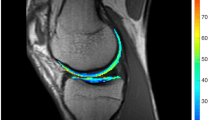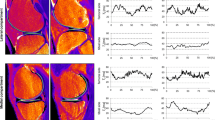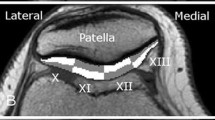Abstract
Purpose
The purpose was to investigate the in vivo effects of unloading and compression on T1-Gd relaxation times in healthy articular knee cartilage.
Materials and methods
Ten volunteers were enrolled, and dGEMRIC images of their right knee joints were obtained using 3.0-T MR at three timepoints: directly following exercise (“baseline”), approximately 15 min after unloading (“unloading”) and during application of a compressive force (50% of the body weight) generated by a loading device via a footplate (“compression”).
Results
Our analysis of variance of pooled data from all cartilage zones demonstrated a significant mean T1-Gd decrease of 56.6 ms between baseline and compression (p < 0.001), and a significant mean decrease of 42.1 ms between unloading and compression (p < 0.001). No significant difference was found between baseline and unloading. Higher mean T1-Gd values were observed in the cartilage contact zone (central femoral and tibial zones; 698.3 ± 162.2 ms) than in the non-contact zone (anterior and posterior femoral and tibial zones, and dorsal femoral zone; 662.9 ± 149.3 ms; p < 0.01).
Conclusion
T1-Gd times appear to be sensitive to mechanical cartilage stress, and thus, further studies are warranted that investigate the relationship between the biochemical load response and the biomechanical properties of articular cartilage.



Similar content being viewed by others
References
Bashir A, Gray ML, Boutin RD, Burstein D (1997) Glycosaminoglycan in articular cartilage: in vivo assessment with delayed Gd(DTPA)(2-)-enhanced MR imaging. Radiology 205:551–558
Link TM, Stahl R, Woertler K (2007) Cartilage imaging: motivation, techniques, current and future significance. Eur Radiol 17:1135–1146
Burstein D, Gray ML (2006) Is MRI fulfilling its promise for molecular imaging of cartilage in arthritis? Osteoarthritis Cartilage 14:1087–1090
Trattnig S, Millington SA, Szomolanyi P, Marlovits S (2007) MR imaging of osteochondral grafts and autologous chondrocyte implantation. Eur Radiol 17:103–118
Heinegaard D, Bayliss M, Lorenzo P (2003) Biochemistry and metabolism of normal and osteoarthritic cartilage. In: Brandt KD, Doherty M, Lohmander LS (eds) Osteoarthritis. 2nd edn. Oxford University Press, New York, pp 72–82
Wayne JS, Kraft KA, Shields KJ, Yin C, Owen JR, Disler DG (2003) MR imaging of normal and matrix-depleted cartilage: correlation with biomechanical function and biochemical composition. Radiology 228:493–499
Williams A, Oppenheimer RA, Gray ML, Burstein D (2003) Differential recovery of glycosaminoglycan after IL-1-induced degradation of bovine articular cartilage depends on degree of degradation. Arthritis Res Ther 5:97–105
Korhonen RK, Laasanen MS, Töyräs J, Rieppo J, Hirvonen J, Helminen HJ et al (2002) Comparison of the equilibrium response of articular cartilage in unconfined compression, confined compression and indentation. J Biomech 35:903–909
Kurkijärvi JE, Nissi MJ, Kiviranta I, Jurvelin JS, Nieminen MT (2004) Delayed gadolinium-enhanced MRI of cartilage (dGEMRIC) and T2 characteristics of human knee articular cartilage: topographical variation and relationships to mechanical properties. Magn Reson Med 52:41–46
Nieminen MT, Töyräs J, Laasanen MS, Silvennoinen J, Helminen HJ, Jurvelin JS (2004) Prediction of biomechanical properties of articular cartilage with quantitative magnetic resonance imaging. J Biomech 37:321–328
Nissi MJ, Rieppo J, Töyräs J, Laasanen MS, Kiviranta I, Nieminen MT et al (2007) Estimation of mechanical properties of articular cartilage with MRI - dGEMRIC, T2 and T1 imaging in different species with variable stages of maturation. Osteoarthr Cartil 15:1141–1148
Juras V, Bittsansky M, Majdisova Z, Szomolanyi P, Sulzbacher I, Gäbler S et al (2008) In vitro determination of biomechanical properties of human articular cartilage in osteoarthritis using multi-parametric MRI. J Magn Reson. doi:10.1016/j.jmr.2008.11.019
Trattnig S, Mamisch TC, Pinker K, Domayer S, Szomolanyi P, Marlovits S et al (2008) Differentiating normal hyaline cartilage from post-surgical repair tissue using fast gradient echo imaging in delayed gadolinium-enhanced MRI (dGEMRIC) at 3 Tesla. Eur Radiol 18:1251–1259
Burstein D, Velyvis J, Scott KT, Stock KW, Kim YJ, Jaramillo D et al (2001) Protocol issues for delayed Gd (DTPA)(2-)-enhanced MRI: (dGEMRIC) for clinical evaluation of articular cartilage. Magn Reson Med 45:36–41
Nishii T, Kuroda K, Matsuoka Y, Sahara T, Yoshikawa H (2008) Change in knee cartilage T2 in response to mechanical loading. J Magn Reson Imaging 28:175–180
Rubenstein JD, Kim JK, Henkelman RM (2006) Effects of compression and recovery on bovine articular cartilage: appearance on MR images. Radiology 201:843–850
Grunder W, Kanowski M, Wagner M, Werner A (2000) Visualization of pressure distribution within loaded joint cartilage by application of angle-sensitive NMR microscopy. Magn Reson Med 43:884–891
Herberhold C, Faber S, Stammberger T, Steinlechner M, Putz R, Englmeier KH et al (1999) In situ measurement of articular cartilage deformation in intact femoropatellar joints under static loading. J Biomech 32:1287–1295
Chen CT, Fishbein KW, Torzilli PA, Hilger A, Spencer RG, Horton WE Jr (2003) Matrix fixed-charge density as determined by magnetic resonance microscopy of bioreactor-derived hyaline cartilage correlates with biochemical and biomechanical properties. Arthritis Rheum 48:1047–1056
Owman H, Tiderius CJ, Neuman P, Nyquist F, Dahlberg LE (2008) Association between findings on delayed gadolinium-enhanced magnetic resonance imaging of cartilage and future knee osteoarthritis. Arthritis Rheum 58:1727–1730
Liess C, Lüsse S, Karger N, Heller M, Glüer CC (2002) Detection of changes in cartilage water content using MRI T2-mapping in vivo. Osteoarthr Cartil 10:907–913
Chen MI, Branch TP, Hutton WC (1996) Is it important to secure the horns during lateral meniscal transplantation? A cadaveric study. Arthroscopy 12:174–181
Kurkijärvi JE, Nissi MJ, Rieppo J, Töyräs J, Kiviranta I, Nieminen MT et al (2008) The zonal architecture of human articular cartilage described by T2 relaxation time in the presence of Gd-DTPA2-. Magn Reson Imaging 26:602–607
Roos EM, Dahlberg L (2005) Positive effects of moderate exercise on glycosaminoglycan content in knee cartilage: a four-month, randomized, controlled trial in patients at risk of osteoarthritis. Arthritis Rheum 52:3507–3514
Tiderius CJ, Svensson J, Leander P, Ola T, Dahlberg L (2004) dGEMRIC (delayed gadolinium-enhanced MRI of cartilage) indicates adaptive capacity of human knee cartilage. Magn Reson Med 51:286–290
Author information
Authors and Affiliations
Corresponding author
Rights and permissions
About this article
Cite this article
Mayerhoefer, M.E., Welsch, G.H., Mamisch, T.C. et al. The in vivo effects of unloading and compression on T1-Gd (dGEMRIC) relaxation times in healthy articular knee cartilage at 3.0 Tesla. Eur Radiol 20, 443–449 (2010). https://doi.org/10.1007/s00330-009-1559-3
Received:
Revised:
Accepted:
Published:
Issue Date:
DOI: https://doi.org/10.1007/s00330-009-1559-3




